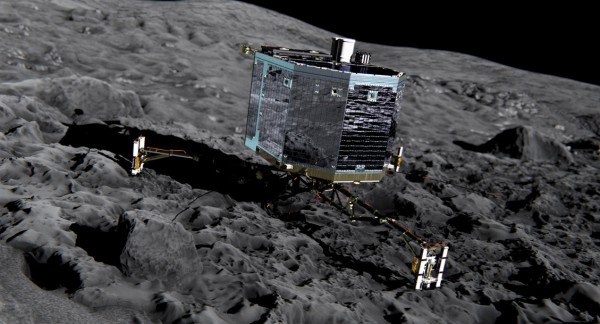By Ana Verayo, | February 12, 2016

Scientists say goodbye to Philae comet lander after failing to re-establish contact.
Scientists of the European Space Agency has finally given up hope on establishing contact again with the lost space probe Philae, which landed successfully on a comet known as 67P/Churyumov-Gerasimenko in November 2014.
Like Us on Facebook
The lander suffered a bumpy landing, bouncing off several times on the surface of the comet, before settling under a deep shadow of a cliff, losing solar power in the process.
Mission scientists from the German Aerospace Center (DLR) announced on Friday that there is a big possibility that Philae is now non-operational as it is now too cold to turn on and is covered in dust.
According to project manager from Philae at the DLR, Stephan Ulamec, the DLR team believes that there is unfortunately zero probability to re-establish contact with Philae, and we decided to no longer send out any commands.
Philae is the first man made spacecraft to land on a comet, making this a milestone in space exploration. Although it was deployed from its mothership, the Rosetta spacecraft, that is currently orbiting the comet, the lander did not reach its target landing point where it can no longer be recharged under a shade.
Last June, when the comet reached its nearest point in orbit around the sun, the lander suddenly woke up and made contact that gave mission scientists hope that Philae would somehow complete some experiments before its solar powered batteries run out.
Since July 9, Philae has not yet made contact again with the Rosetta spacecraft including the last attempts to gain contact with the robotic lander failed once more. Ulamec says that it would be very surprising if a signal from Philae would be received this time.
The mission team believes that Philae is not covered with ice, but the solar panels of the tiny lander would have been completely covered in dust.
Apart from this dust, temperatures on the comet can dip below 180 degrees Celsius below zero when the comet 67P moves further away from the sun, making the surface so cold that Philae's systems could not withstand these harsh conditions.
Even if Philae did not complete all its experiments due to its short lifespan on the comet, crucial data was gathered by the time it landed on the surface that changed how scientists view comets and even provided good lessons for future missions.
Rosetta will soon capture some images of the comet during its flybys by the summer, where it will execute its final flyby, landing on the comet itself as the mission ends in September 2016.
-
Use of Coronavirus Pandemic Drones Raises Privacy Concerns: Drones Spread Fear, Local Officials Say

-
Coronavirus Hampers The Delivery Of Lockheed Martin F-35 Stealth Fighters For 2020

-
Instagram Speeds Up Plans to Add Account Memorialization Feature Due to COVID-19 Deaths

-
NASA: Perseverance Plans to Bring 'Mars Rock' to Earth in 2031

-
600 Dead And 3,000 In The Hospital as Iranians Believed Drinking High-Concentrations of Alcohol Can Cure The Coronavirus

-
600 Dead And 3,000 In The Hospital as Iranians Believed Drinking High-Concentrations of Alcohol Can Cure The Coronavirus

-
COVID-19: Doctors, Nurses Use Virtual Reality to Learn New Skills in Treating Coronavirus Patients







